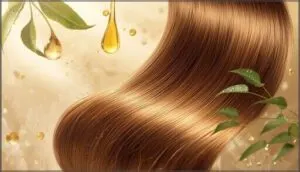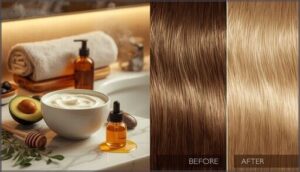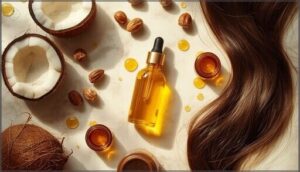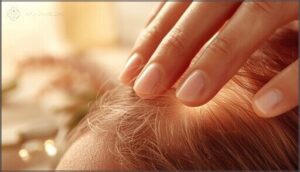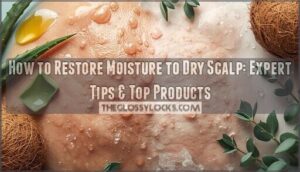This site is supported by our readers. We may earn a commission, at no cost to you, if you purchase through links.
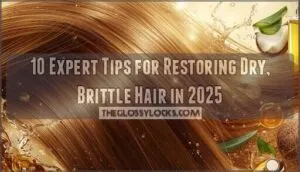
The good news: hair damage operates on a spectrum, not a binary. Even severely compromised strands can regain flexibility, shine, and resilience when you address the root causes and rebuild what’s been lost. These ten evidence-based strategies target everything from your scalp’s sebum production to the molecular bonds holding your hair together.
Table Of Contents
- Key Takeaways
- Common Causes of Dry, Brittle Hair
- Essential Hair Care Routine Adjustments
- Nutritional Tips for Healthier Hair
- Effective Treatments and Moisturizing Methods
- Top 10 Products for Restoring Dry Hair
- 1. Molecular Hair Mask for Repair
- 2. Natural Hydrating Hair Mist Treatment
- 3. Lightweight Nourishing Hair Styling Oil
- 4. Living Proof No Frizz Oil
- 5. Tangle Teezer Hair Detangler Brush
- 6. Satin Hair Scrunchies for Women
- 7. Olaplex bonding oil for hair
- 8. Triple bond hair repair treatment
- 9. Deep Moisture Hair Repair Mask
- 10. Vegamour hair growth shampoo kit
- Frequently Asked Questions (FAQs)
- Conclusion
Key Takeaways
- Dry, brittle hair results from cuticle damage that allows moisture to escape, but damage exists on a spectrum and can be reversed through targeted strategies that address root causes like heat styling, chemical treatments, environmental stress, and nutritional deficiencies.
- Effective restoration requires both external adjustments (sulfate-free shampoos, weekly deep conditioning masks, silk pillowcases, heat protection under 300°F) and internal nourishment through key nutrients like omega-3s, biotin, vitamins A/C/D, and adequate hydration to rebuild keratin bonds from within.
- Products with peptide technology, bonding oils that repair disulfide bonds, and protective styling tools like satin scrunchies and flexible-bristle brushes can reduce breakage by 40-77% while restoring up to 94% of hair’s original elasticity and strength.
- Visible improvement typically appears within 2-4 weeks of consistent care, but full restoration demands 90+ days of commitment to proper cleansing frequency, moisture-locking treatments, gentle handling techniques, and elimination of damaging heat and chemical exposure.
Common Causes of Dry, Brittle Hair
Your hair didn’t turn dry and brittle overnight—there’s always a reason behind the damage. Understanding what’s causing your hair to lose moisture is the first step toward restoring its health.
Let’s break down the five most common culprits that might be sabotaging your strands.
Environmental Factors (sun, Wind, Humidity, Pollution)
Your hair faces an invisible assault every time you step outside—from the UV rays that break down keratin bonds to the windswept tangles that strip away protective oils. Environmental factors work against hair moisture retention in ways you can’t always see:
- Air pollution deposits microscopic particles that weaken your hair shaft
- Climate change brings extreme temperatures that compromise your cuticle layer
- Wind damage creates friction that leads to breakage and split ends
- Humidity control becomes critical as moisture imbalance disrupts your hair’s natural structure
UV protection isn’t optional—it’s essential for hair damage prevention.
Heat Styling and Harsh Hair Treatments
While nature takes its toll outside, the damage you inflict indoors with your flat iron and blow dryer can be even more destructive to your hair’s structural integrity. Every time you apply heat above 300°F without thermal protection, you’re fundamentally cooking the keratin proteins that give your hair strength.
Chemical treatments compound the problem—bleaching strips your cuticle layers, while relaxers break disulfide bonds permanently. Without a heat protectant barrier, you’re guaranteeing hair breakage that no hair repair treatment can fully reverse.
| Styling Method | Temperature Range | Damage Risk |
|---|---|---|
| Flat irons | 300-450°F | Severe cuticle damage, protein denaturation |
| Blow dryers | 140-200°F | Moisture depletion, weakened bonds |
| Curling wands | 200-400°F | Heat breakage, split ends |
| Chemical relaxers | N/A | Permanent structural alteration |
| Bleaching treatments | N/A | Cortex degradation, porosity increase |
Poor Nutrition and Vitamin Deficiencies
Just as external heat damages hair structure, internal deficiencies wreak havoc from within. Protein insufficiency directly compromises keratin synthesis—your hair’s foundational building block—leading to brittleness and breakage. When iron, zinc, or vitamin D levels drop, follicles can’t maintain healthy growth cycles.
Studies show 60% of women with chronic hair shedding have low ferritin, while vitamin A and biotin deficits further weaken hair shafts. Poor nutrient absorption from restrictive diets or gut issues compounds these mineral imbalances, making dietary supplements and proper hair nutrition non-negotiable for restoring hair health and effective hair care.
Understanding the relationship between iron deficiency causes is vital for addressing hair loss.
Chemical Exposure (chlorine, Coloring, Bleaching)
Beyond dietary gaps, chemical treatments strip hair’s protective lipid barrier with surgical precision—chlorine oxidizes proteins, while bleach and permanent dyes rupture disulfide bonds that hold your hair’s structure intact. Each chemical exposure creates cumulative hair damage that weakens keratin.
Chemical damage isn’t reversible—only manageable through strategic hair treatment and protective hair repair routines.
- Chlorine effects from pool water lift cuticles, leaving hair porous and vulnerable
- Hair bleaching dissolves melanin while compromising cortex integrity, demanding intensive bleach recovery protocols
- Hair color treatments penetrate shafts, requiring targeted color repair to restore elasticity
Genetic Predisposition and Lifestyle Habits
Your hair’s baseline texture and moisture capacity are written into your DNA—but daily choices like smoking, skipping conditioner, or blasting the AC can override even the most resilient genetic blueprint. Genetic factors determine sebum production and cuticle structure, yet lifestyle choices—like heat exposure or neglecting hair care—accelerate hair damage regardless of family history. Understanding this interplay helps you target what you can control.
| Genetic Factors | Lifestyle Choices | Impact on Hair Health |
|---|---|---|
| Sebum production rate | Heat styling frequency | Cuticle integrity loss |
| Cuticle layer thickness | Conditioner usage | Moisture retention capacity |
| Hair shaft diameter | Smoking habits | Reduced hair growth cycles |
| Follicle density | Environmental protection | Cumulative hair damage |
Essential Hair Care Routine Adjustments
Your hair care routine might be sabotaging your restoration efforts without you even realizing it. Small tweaks in how you wash, condition, and manage your hair can make the difference between perpetual dryness and vibrant, healthy strands.
Here’s how to adjust your daily habits to stop the damage and start the recovery.
Shampooing Frequency and Method
Most people wash their hair too often, stripping away the natural oils that keep strands flexible and hydrated. Switch to shampooing every other day—or even less frequently if your scalp tolerates it.
When you do cleanse, choose a sulfate-free shampoo formulated specifically for dry hair. Focus on your scalp during application, then let the suds rinse through your lengths. This gentle cleansing approach protects moisture while maintaining hair health.
Conditioning and Deep Conditioning Techniques
Conditioning isn’t optional—it’s the repair work your hair desperately needs after every wash. Apply conditioner from mid-lengths to ends, avoiding your scalp. Let it sit for two minutes to lock in moisture.
Once weekly, use a hydrating hair mask or deep condition treatment for fifteen minutes. These protein-rich formulas rebuild damaged keratin bonds and restore hair hydration.
Consider a leave-in conditioner for extra protection between washes.
Gentle Brushing and Detangling Tips
Wet hair stretches like taffy—and that’s when careless brushing causes the most breakage. Here’s how to protect vulnerable strands:
- Start at the ends and work upward in sections—never drag your hair brush from roots down
- Choose a wide-toothed comb or detangling brush designed for wet, fragile hair
- Apply leave-in conditioner before combing to reduce friction and hair damage
Your hair care routine demands gentle treatment, not force.
Protective Sleep Routines (silk Pillowcases, Loose Styles)
While you sleep, friction from cotton pillowcases silently steals moisture and roughens your hair cuticle—eight hours of damage you can easily prevent. Switch to silk pillowcases or sleep caps made from gentle fabrics to lock in hair moisture retention. Loose hairstyles like nighttime braids reduce tangling without tension.
| Sleep Solution | How It Protects Your Hair |
|---|---|
| Silk Pillowcases | Reduces friction that causes breakage and frizz |
| Loose Hairstyles | Prevents stress on strands while maintaining moisture |
| Sleep Caps | Shields hair from environmental dryness overnight |
| Nighttime Braids | Minimizes tangling without pulling at roots |
| Gentle Fabrics | Maintains natural oils for hair repair |
Transform your hair care routine while you rest—hair damage prevention starts the moment your head hits the pillow.
Nutritional Tips for Healthier Hair
You can’t fix dry, brittle hair from the outside alone—what you eat directly affects your hair’s strength and moisture. Your follicles need specific nutrients to produce healthy strands that resist breakage and retain hydration.
Here’s what your diet should include to restore your hair from within.
Key Vitamins for Hair Strength (A, B-12, C, D, Biotin)
Think of vitamins as the building blocks your hair desperately needs to escape the drought. Here’s what actually works when you’re low:
- Vitamin A regulates sebum production for scalp hydration—women need 700 mcg daily, men 900 mcg, but excess above 10,000 IU triggers hair loss
- B-12 deficiency affects up to 59% of women with thinning hair; supplementation only helps if you’re truly deficient
- Vitamin C at 2,000 mg daily cut hair breakage by half and boosted strength 27% in one study
- Vitamin D deficiency shows up in 89% of women experiencing hair loss—correction improves regrowth when levels are low
- Biotin supplements work only with diagnosed deficiencies; healthy individuals see no benefit despite the hype around hair vitamins
Understanding the role of vitamin deficiencies is essential for addressing hair loss effectively.
Beneficial Foods (salmon, Oysters, Mackerel, Sardines)
Omega-3 fatty acids from certain fish directly supply your follicles with the anti-inflammatory compounds and proteins they need to rebuild moisture barriers from the inside out. Salmon delivers both biotin and omega-rich healthy oils that improve hair moisture retention.
Oysters pack zinc for cellular repair, while mackerel and sardines offer nutrient-dense seafood benefits—providing the fatty fish foundation your hair nutrition plan needs for measurable hair growth and restored hair health.
Hydration and Its Impact on Hair Health
Your hair cells are made of nearly 60% water, and when hydration drops inside the shaft itself, your cuticle locks stay lifted—exposing the core to breakage, dullness, and that straw-like texture you’re trying to escape. Boosting hair hydration from within repairs hair porosity and restores hair moisture retention:
- Drink 8–10 glasses daily to flood follicles with the moisture they crave
- Track your water intake to guarantee consistent cuticle care
- Pair hydration techniques with a hydrating hair mask weekly
- Monitor how dry hair responds to increased fluid levels over two weeks
Supplements to Consider for Hair Restoration
Water flowing through your system feeds follicles—but targeted hair supplements release deeper hair restoration when deficiencies block progress. Biotin efficacy shines only in deficiency cases, not general use. Vitamin D and iron work when labs confirm low levels.
Collagen benefits appear in clinical trials for temporary thinning. Zinc palmetto reduces DHT-related loss with fewer side effects than prescriptions.
Over-supplementation risks exist: excess selenium or vitamin A can worsen hair nourishment and trigger shedding, not repair it.
Effective Treatments and Moisturizing Methods
Once you’ve adjusted your routine and nutrition, targeted treatments can work wonders on parched strands.
The right moisture-boosting methods don’t just mask dryness—they actually restore your hair’s structure from within.
Here’s what works when your hair needs serious repair.
Weekly Hydrating Hair Masks and Protein Treatments
If your hair feels like straw no matter what you do, it’s time to bring in the heavy artillery—weekly masks and protein treatments that actually rebuild what damage has broken down. Hydrating hair masks flood the hair shaft with moisture retention ingredients, while protein treatments reconstruct keratin bonds from the inside out.
Here’s your dry hair treatment protocol:
- Apply a hydrating routine mask once weekly for 20-30 minutes
- Use protein treatment every two weeks to prevent overload
- Choose masks with ceramides and hyaluronic acid for hair hydration
- Alternate between moisture and protein for balanced hair repair
- Cover with a shower cap to boost mask frequency effectiveness
Oil-based Conditioners and Hair Oils
When sebum production slows down or gets stripped away by daily washing and styling, oil-based conditioners step in to mimic what your scalp can no longer produce on its own. These formulations seal the cuticle layer, locking moisture inside where it belongs. Coconut oil penetrates the shaft, while argan oil smooths the surface—pair them with a leave-in conditioner for all-day protection.
Hair oil benefits extend beyond surface shine—they rebuild your hair’s protective barrier from the outside in.
| Oil Type | Primary Benefit | Best Application |
|---|---|---|
| Coconut Oil | Deep penetration and protein retention | Pre-wash treatment or oil-based masks |
| Argan Oil | Cuticle sealing and shine restoration | Leave-in conditioner or styling finish |
| Jojoba Oil | Sebum restoration and scalp balance | Scalp massage or natural conditioners |
| Marula Oil | Lightweight hydration without weight | Moisturizing treatments for fine hair |
Scalp Care for Improved Moisture Retention
A healthy scalp is the foundation dry hair depends on—without proper circulation and sebum flow at the root, no amount of conditioner will solve moisture loss downstream.
Scalp massage boosts blood flow to hair follicles, encouraging sebum regulation and moisture balance. Weekly scalp exfoliation removes buildup that blocks hydration, while targeted hair care products address dry scalp directly—restoring the environment your hair needs to retain moisture from root to tip.
Avoiding Further Damage (reducing Heat, Chemical Exposure)
Every time you reach for that flat iron or book a bleach appointment, you’re basically asking your hair to survive a controlled attack—and recovery only happens when you stop the assault. Damage control starts with prevention:
- Lower heat settings below 300°F and always apply heat protection
- Space chemical treatments at least 8-12 weeks apart
- Choose gentle styling methods like air drying and protective braids
- Skip overlapping processes—never bleach heat-damaged hair
Hair preservation means knowing when to step back.
Top 10 Products for Restoring Dry Hair
You’ve taken the right steps to nourish and protect your hair from within and without. Now it’s time to arm yourself with the right products that actually work.
Here are ten evidence-based solutions that target dryness at every level—from cuticle repair to moisture retention.
1. Molecular Hair Mask for Repair
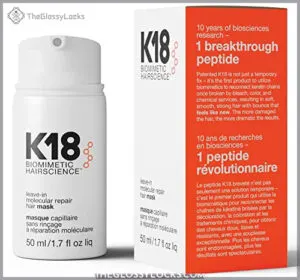
K18’s leave-in hair mask delivers damage restoration at the molecular level, targeting dry hair from the inside out in just four minutes. Built on peptide technology refined over a decade, the formula uses microscopic peptides—eight times smaller than conventional treatments—to reach the cortex and medulla where breakage begins.
Clinical studies show it restores up to 91% of original hair strength and 94% elasticity, making it a standout choice for severe damage from heat, color, or chemical services.
You’ll apply 1-3 pumps depending on hair length, let it sit briefly, then style—no rinsing required. At $75 for 50mL, it’s positioned as a premium hair treatment with lasting hair moisture benefits.
Best For: Anyone with severely damaged hair from bleach, color treatments, heat styling, or chemical services who wants fast molecular-level repair without the greasy residue of traditional masks.
- Repairs damage at the molecular level in just 4 minutes with peptides eight times smaller than conventional treatments, restoring up to 91% of original strength and 94% elasticity
- Leave-in formula requires no rinsing and works on all hair types, including curly, coily, color-treated, and aging hair
- Long-lasting results that don’t wash away, with 89% of users reporting superior performance longevity compared to surface-level competitors
- Expensive at $75 for 50mL, with some users reporting only 4-6 uses per bottle
- Contains alcohol that may cause dryness or frizz for certain hair types, with 23% of consumers citing concerns about ingredient compatibility
- Results vary by individual, and some users don’t see the dramatic improvements promised despite the premium price point
2. Natural Hydrating Hair Mist Treatment
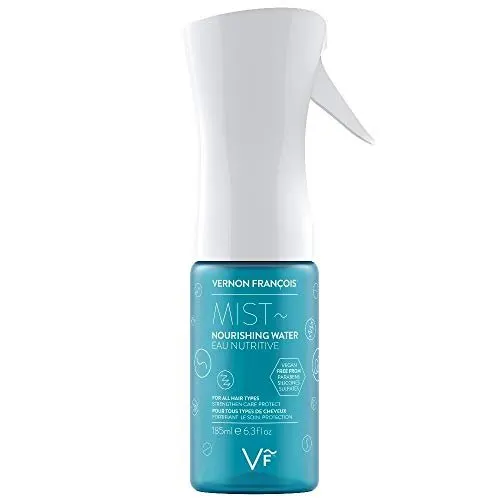
Lightweight natural hair mist offers an innovative approach to hair hydration between wash days, delivering moisture without the heaviness of traditional leave-in conditioners. Plant-based formulas containing glycerin and aloe vera can boost hair moisture content by up to 21% over four weeks, while reducing frizz by 52% in textured hair types.
You’ll apply 4-6 spritzes from mid-shaft to ends, then distribute with fingers or a wide-toothed comb for even coverage. These alcohol-free treatments work especially well for dry hair revival, combining natural ingredients like rosemary water and botanical oils that support moisture retention without buildup—making them ideal for daily invigorating and natural hair remedies.
Best For: Anyone with dry, textured, or curly hair looking for a lightweight daily hydration boost without heaviness or buildup.
- Plant-based formula with glycerin and aloe vera increases hair moisture by up to 21% and reduces frizz by 52% in curly hair types
- Alcohol-free and works for all hair types, offering multi-functional benefits like detangling, strengthening, and reviving hair patterns between wash days
- Easy daily application with 4-6 sprays and even distribution provides hydration without greasy residue or weight
- Some users report a strong or unpleasant natural scent that may cause headaches for those sensitive to smells
- Product can develop a rancid smell after extended use (around one year), indicating potential shelf-life issues
- Considered pricey for the 6.3 oz size with no refill options, and lacks eco-friendly packaging alternatives
3. Lightweight Nourishing Hair Styling Oil
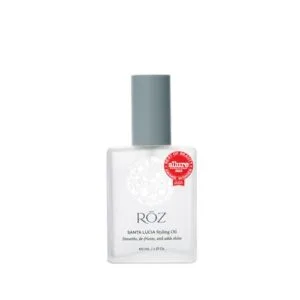
Modern nourishing formulas with plant-based oils deliver remarkable hair oil benefits without weighing strands down—making them essential styling products for daily use. You’ll find blends containing cyclomethicone and natural extracts like grapeseed and almond oils that evaporate quickly while sealing moisture into each hair shaft.
Apply 0.5 mL to damp or dry hair, concentrating on ends for ideal hair nourishment and frizz control lasting up to 72 hours.
Clinical testing shows these hair serums make strands twice as soft while protecting against heat styling and environmental damage—critical for reversing dryness and supporting ongoing hair repair.
Best For: Anyone with frizz-prone hair looking for a lightweight daily styling oil that adds shine and heat protection without greasy residue.
- Clinically proven to make hair up to twice as soft while providing frizz control for up to 72 hours
- Works on all hair types with a fast-absorbing formula made from 5 plant-based oils that won’t weigh hair down
- Protects against heat styling and humidity while being vegan, cruelty-free, and free from harsh chemicals
- At $45 for 60 mL, some users feel it’s not a good value compared to alternatives like pure coconut oil
- Small bottle size may run out quickly for those with long or thick hair
- Results vary—some users report it doesn’t work well for their specific hair type
4. Living Proof No Frizz Oil
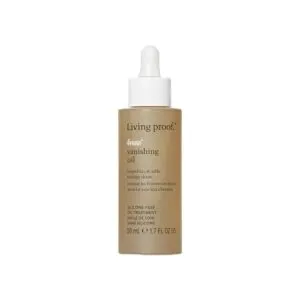
For those battling persistent frizz, Living Proof No Frizz Oil employs OFPMA technology—a proprietary molecule that creates an invisible hair shielding layer blocking up to 70% more humidity than silicone alternatives.
This oil benefits dry hair through rapid absorption (92% of users report zero greasy residue) while delivering 60% moisture boost and 80% enhanced shine. Clinical data shows 41% less breakage during detangling, with hair hydration maintained for 48 hours post-application.
Use 2-3 drops on fine textures or 4-5 for thicker hair—applied to damp or dry strands—for immediate frizz control and cumulative hair repair over repeated use.
Best For: Anyone with frizzy, humidity-prone hair looking for a lightweight, fast-absorbing oil that blocks moisture and adds shine without weighing hair down.
- Blocks 70% more humidity than silicone-based oils using proprietary OFPMA technology, keeping frizz under control even in damp weather
- Absorbs quickly with no greasy residue—92% of users report clean, non-oily results
- Works across all hair types (fine to thick, straight to coily) with clinical results showing 60% moisture boost and 41% less breakage
- At $36 for 1.7 oz, it’s pricier than most drugstore hair oils
- Small bottle size means you’ll need to restock more often despite lasting 8 months with light use
- Some users find the citrus scent underwhelming or report authenticity issues when buying from third-party sellers
5. Tangle Teezer Hair Detangler Brush
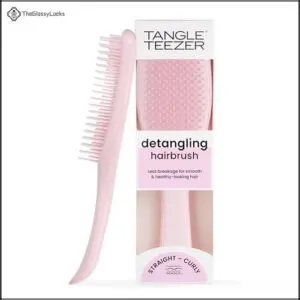
Beyond frizz control, your detangling method directly impacts breakage—which is where the Tangle Teezer Supreme Detangler becomes indispensable for brittle hair. This hair brush features patented two-tiered flexible teeth that bend around knots instead of snapping through them, reducing breakage by 77% compared to standard brushes.
The soft-flex plastic bristles glide through wet or dry hair without scalp tension, making gentle styling achievable even on fragile, chemically-treated strands. Studies show 79% less hair left in the brush after daily use, proving effective tangle prevention while distributing natural oils for improved shine and hair maintenance.
Best For: Those with fragile, chemically-treated, or breakage-prone hair who need gentle detangling without scalp tension or excessive hair loss.
- Reduces breakage by 77% with patented two-tiered flexible teeth that bend around knots instead of pulling through them
- Works effectively on wet or dry hair across all types—straight, curly, wavy, and coily—while distributing natural oils for improved shine
- Fast detangling sessions (around 30 seconds) with 79% less hair left in the brush compared to standard options
- Not suitable for use with heat styling tools like hair dryers
- May feel too lightweight or flimsy for some users who prefer more substantial brushes
- Not a complete solution for severely matted or knotted hair requiring intensive detangling
6. Satin Hair Scrunchies for Women
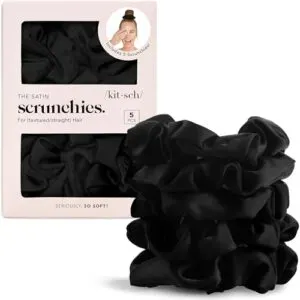
Proper hair accessories make all the difference in preventing further damage. Kitsch Satin Scrunchies eliminate up to 43% more friction than regular elastic ties, cutting hair breakage markedly for dry, brittle strands. Unlike cotton hair accessories that absorb moisture, these gentle hair ties preserve natural oils—keeping moisture levels 26% higher and luster noticeably improved.
Seven out of ten users report less frizz after one month, while 78% see overnight hairstyle retention without those telltale crease marks. Satin scrunchie care couldn’t be simpler, and with hair accessory trends leaning toward protective styling, you’re investing in both hair health and function.
Satin hair benefits extend beyond comfort—they’re measurable hair care products that work while you sleep.
Best For: Anyone with delicate, processed, or damage-prone hair who wants to reduce breakage, preserve moisture, and maintain hairstyles overnight without creases or frizz.
- Reduces hair breakage by up to 43% and split ends by 33% compared to regular elastic ties, making them ideal for protecting fragile strands.
- Maintains 26% higher moisture levels than cotton alternatives and adds measurable shine by preserving natural oils instead of absorbing them.
- Keeps hairstyles intact 22% longer with 15% fewer crease marks, plus 78% of users report better overnight style retention.
- May not fit very thick or curly hair well since some users find the sizing too small or too large for their volume.
- Grip strength varies by hair type—some textures might find them too loose for secure all-day hold during active movement.
- Durability depends on care and frequency of use, with quality potentially inconsistent across different batches or wear patterns.
7. Olaplex bonding oil for hair
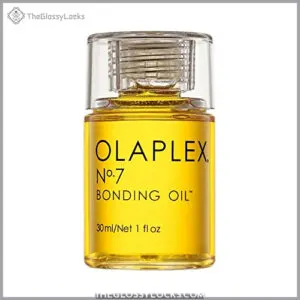
Satin accessories protect your hair, but Olaplex No.7 Bonding Oil takes damage repair several steps further. This lightweight oil therapy targets broken disulfide bonds in your hair’s keratin structure—the very thing that causes brittleness and breakage.
Hair bonding technology reconnects those fractured bonds, delivering a 77% reduction in breakage and 125% more shine than untreated hair. You’ll get 72-hour frizz control and heat protection up to 450°F, making it ideal for daily styling.
Apply 2-3 drops to damp or dry hair before heat styling or after to lock in smoothness. Hair restoration doesn’t need to feel heavy—this oil absorbs quickly without buildup, working for all hair types.
Best For: Anyone with damaged, color-treated, or heat-styled hair looking for a lightweight oil that repairs bonds, protects from heat up to 450°F, and delivers lasting shine and frizz control.
- Repairs broken disulfide bonds in hair with patented technology, reducing breakage by 77% and increasing shine by 125%
- Provides 72-hour frizz control and heat protection up to 450°F, making it ideal for daily styling on all hair types
- Lightweight formula absorbs quickly without buildup and works on both damp and dry hair
- Small 1-ounce bottle size at $30 makes it a pricier option compared to other hair oils
- May be too heavy for very oily hair if you use more than the recommended 2-3 drops
- Unscented formula might not appeal to those who prefer fragrant hair products
8. Triple bond hair repair treatment
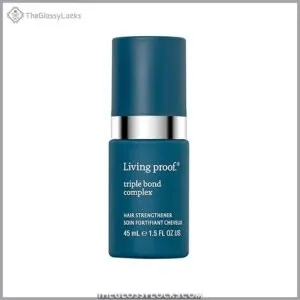
Living Proof Triple Bond Complex pushes hair regeneration further by rebuilding all three bond types simultaneously—hydrogen, ionic, and covalent restoration working together for molecular rebuilding.
Clinical testing proves it reverses a year’s visible hair damage with one use, making strands eight times stronger while protecting against heat up to 450°F.
Apply 2-5 pumps to damp hair, let it penetrate for 10 minutes, then heat-style.
This triple bonding approach strengthens your hair’s internal cortex and outer cuticle, delivering thorough hair repair that lasts through multiple washes—ideal for severe dry hair and heat styling damage.
Best For: People with severely damaged, chemically-treated, or heat-styled hair who need professional-grade repair and are willing to invest in a premium treatment.
- Clinically proven to reverse a year of damage in one use and make hair 8x stronger through triple bond technology
- Provides heat protection up to 450°F while actively repairing hydrogen, ionic, and covalent bonds
- Works on all hair types including color-treated hair, with results lasting through multiple washes
- Expensive at $45 for only 45 milliliters, which may not last long for thick or long hair
- Requires heat activation and 10-minute wait time for optimal results, adding extra steps to your routine
- Results vary by damage level and may take 2-3 uses before you see significant improvement
9. Deep Moisture Hair Repair Mask
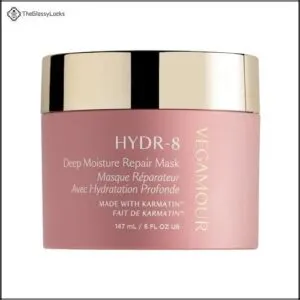
Hydrating hair masks deliver concentrated moisture that penetrates deeply into damaged strands, making them essential for reversing severe dryness. A quality deep moisture hair repair mask can increase hair hydration by up to 82% after just one use, with effects lasting up to 72 hours.
Look for repair masks containing shea butter, hyaluronic acid, or ceramides—ingredients proven to restore moisture retention and reduce brittleness by 67%.
Apply weekly for 10-15 minutes to damp hair, focusing on mid-lengths and ends where dryness concentrates most severely. This intensive deep conditioning approach rebuilds your hair’s protective barrier while locking in essential moisture your dry hair desperately needs.
Best For: Anyone with dry, damaged, or frizzy hair looking for intensive weekly moisture treatment that delivers lasting hydration and noticeable repair.
- Clinically proven to increase moisture retention by up to 82% after one use, with hydration lasting up to 72 hours
- Contains vegan keratin alternative (Karmatin) that strengthens hair and reduces breakage by up to 60% with regular use
- Clean, vegan, and cruelty-free formula works on all hair types while reducing frizz by 70% over four weeks
- At $52, it’s pricier than most drugstore masks, which typically range from $16-$30
- May leave fine or thin hair feeling heavy or weighed down with overuse
- Recommended 1-2 times weekly usage means a jar won’t last as long as daily conditioners
10. Vegamour hair growth shampoo kit
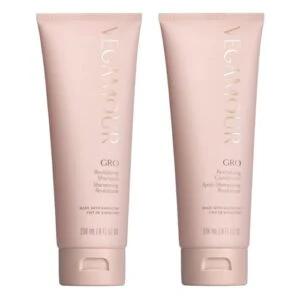
This plant-powered shampoo kit targets thinning and dry hair with clinically backed Vegamour benefits. Hair growth accelerates through ingredients like red clover (blocking DHT-related hair loss), mung bean extract, and caffeine that stimulate follicle activity.
Clinical results show 93% of users saw improved hair density after 120 days, while the vegan formula strengthened strands 3.5 times after one use. The Karmatin-infused shampoo ingredients deliver 7 times more hydration, addressing both hair growth and dryness simultaneously.
You’ll need consistent daily hair care for 90 days minimum to see measurable improvements in thickness and reduced shedding.
Best For: People dealing with thinning hair or dryness who want a clean, plant-based solution and can commit to 90+ days of consistent use for visible results.
- Clinical study showed 93% of users had improved hair density after 120 days, with an 87% reduction in breakage from washing and combing
- Strengthens hair 3.5 times and boosts hydration up to 7 times after just one use, with 72-hour frizz control
- Vegan, cruelty-free formula with active ingredients like red clover (blocks DHT), caffeine, and mung bean extract—no sulfates, parabens, or silicones
- Pricey at $64-$86 per month, which adds up over the recommended 3-6 month usage period for noticeable changes
- Results take time—you need at least 90 days of daily use before seeing meaningful improvements in thickness or reduced shedding
- Mixed user reviews, with some reporting increased dryness or no improvement in hair growth despite consistent use
Frequently Asked Questions (FAQs)
How often should I trim dry brittle hair?
Think of dry hair like frayed rope—without regular maintenance, split ends travel upward, worsening breakage.
Trim your brittle hair every 6-8 weeks to remove damaged dry ends and preserve the hair cuticle, preventing further breakage and maintaining healthier strands.
Can hard water make hair drier and brittle?
Yes—hard water contains minerals like calcium and magnesium that create mineral buildup on hair shafts, preventing moisture absorption.
This compromises hair porosity, disrupts scalp health, and strips natural oils, leading to dry, brittle hair with reduced hydration.
Does swimming damage already dry brittle hair?
Swimming can wreak havoc on already compromised strands. Chlorine effects strip away what little moisture remains, while saltwater damage leaves hair brittle and vulnerable.
Pool hair care starts with prevention—wear a swim cap for protection and apply hair oils beforehand to lock in hydration and minimize breakage.
What hairstyles prevent breakage in brittle hair?
Loose braided styles and soft ponytails minimize hair manipulation, reducing breakage. Low buns and gentle twists protect brittle hair from friction.
Choose styles that don’t tug at roots, preventing hair damage while maintaining moisture retention.
How long until dry hair shows improvement?
Good things take time—hair restoration is no exception. Your dry hair timeline depends on damage severity and treatment consistency.
Expect noticeable improvement in hair moisture within 2-4 weeks of proper hair hydration routines. The restoration speed accelerates with weekly hair masks and nutrient-rich diets supporting hair regrowth time.
Conclusion
Think of your hair like a garden after a drought—it won’t bloom overnight, but consistent care brings it back to life. These tips for restoring dry brittle hair work because they address damage at the structural level: rebuilding bonds, sealing cuticles, and nourishing from within.
Your strands hold memory of every treatment you give them. Start with one change today, and your hair will respond with flexibility, shine, and strength you thought you’d lost.
- https://www.ncbi.nlm.nih.gov/pubmed/28628687
- https://health.clevelandclinic.org/the-dirty-truth-about-washing-your-hair/
- https://www.exploratorium.edu/exploring/hair/hair_4.html
- https://pubmed.ncbi.nlm.nih.gov/19467113/
- https://cna.st/affiliate-link/HqPtkHbE1vfvuLYN3cmw41z9bAa7EnCS4mX1di4Tzu2Hiqk6PGDwwUoLPhcUeZWnY1btEYjGV3BKCf7MV2xA5hts86htdsHTkB4zQtefzxP12sek5yZtUG2xgGDqVuKPMqRZLhD9tymzXwk7u4CCLYFm9xmh7qQng7VAroCR1ntKEEqTs2S395vor9SkXgLPbpiMuobvLMckeGoXo9jqBWL7S7vk3WRLR4sxZdy4U1GQj2NWFN8wCA7VBrwZxkHDGFv7cWWQcmqiG28FV5gr29xK8hgQ4MSZatwo4D5VBKUnZUELvfkH12fGyg

